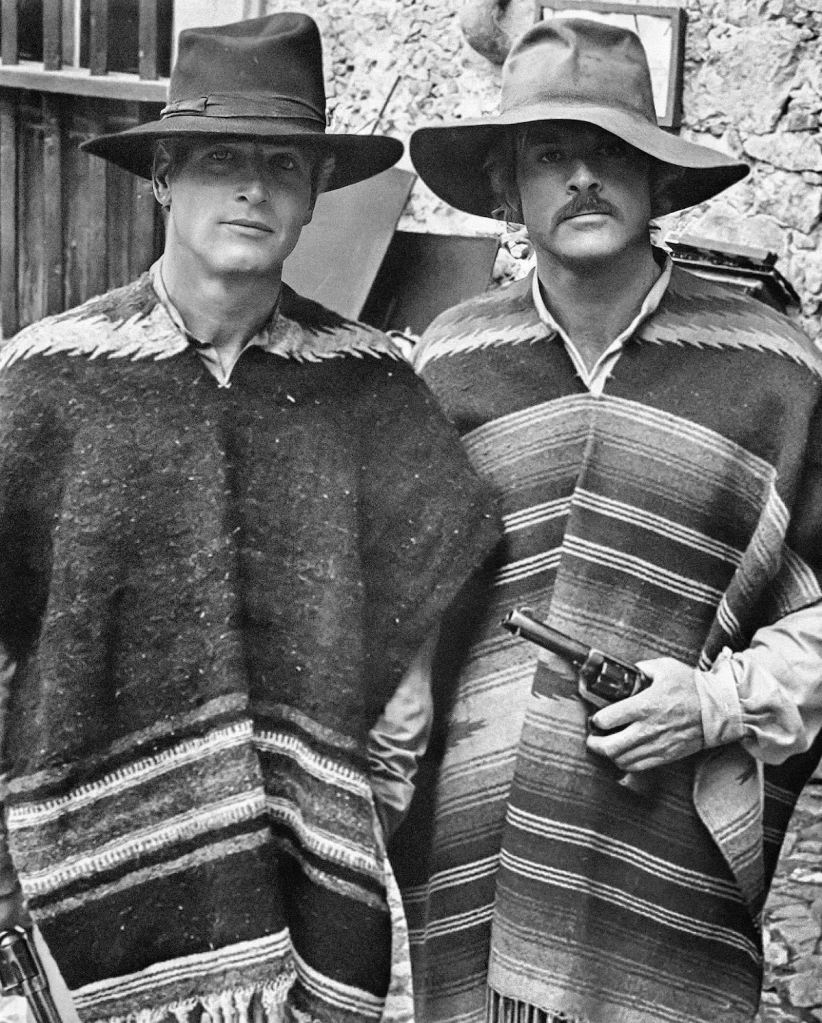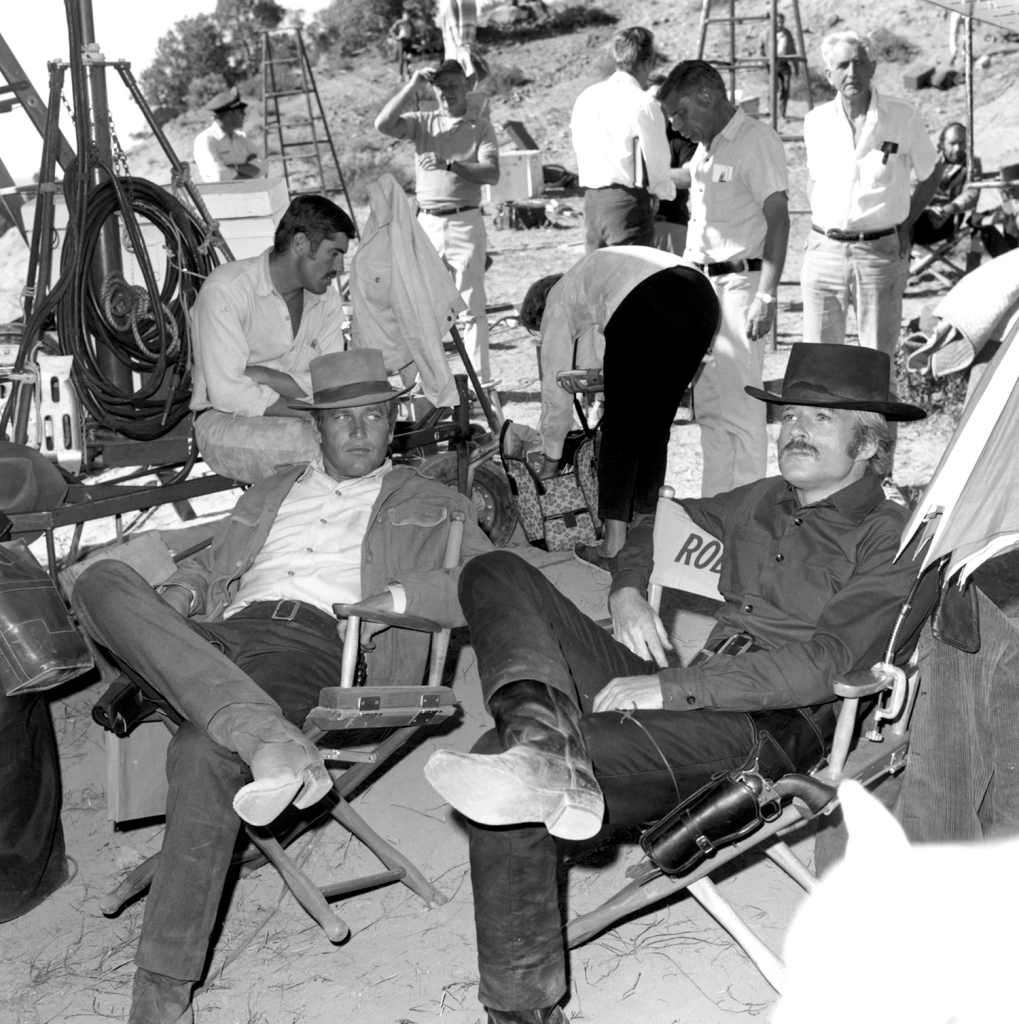According to William Goldman, when he first wrote the script and sent it out for consideration, only one studio wanted to buy it, and that was with the proviso that the two lead characters did not flee to South America. When Goldman protested that that was what had happened, the studio head responded, “I don’t give a shit. All I know is John Wayne don’t run away.” Goldman rewrote the script, “didn’t change it more than a few pages, and subsequently found that every studio wanted it.”
William Goldman said that many young people saw the super posse in ‘Butch Cassidy and the Sundance Kid,’ as a metaphor for the government and authority during the years of anti-war protests. He said his students said the similarity lay in the relentlessness by which both “would hunt you down.”
With nine wins, ‘Butch Cassidy and the Sundance Kid’ currently holds the record for the British Academy Awards (BAFTAs). It won for picture, actor (Robert Redford), actress (Katharine Ross, direction (George Roy Hill), screenplay, cinematography, film editing, sound, and score. It won every award it could, as its tenth nomination was a dual nomination for Best Actor. It was the top-grossing film of 1969, and today is considered one of Hollywood’s greatest westerns. Paul Newman said this was the most fun he’d ever had making a film~ and that he and Robert Redford drank a lot of beer in Mexico. Butch Cassidy and the Sundance Kid was filmed in 1968 in Utah, Colorado, and Mexico. It cost $6 million to film, but earned over $102 million at the box office in 1969, which would be around $725 million currently, adjusted for inflation. On the first day of shooting, involving the train robbery scenes, Katharine Ross came to the set to watch. There were five cameras and only four operators, so cinematographer Conrad L. Hall put her on the extra camera. He showed her how to operate it and how to move it to get her shot. (Katharine Ross was newly divorced at the time, and he divorced his wife to marry Ross) Director George Roy Hill was furious, but said nothing the whole day. At the end of the day, however, George Roy Hill banned Katharine Ross from the set except when she was working. Katharine Ross enjoyed shooting the silent, bicycle riding sequence best, because it was handled by the film crew’s second unit rather than the director. She said, “Any day away from George Roy Hill was a good one.” This was after she had been scolded and banned from the set by Hill for operating a camera, even though cinematographer Conrad Hall, who Ross was dating, invited her to do it. Hall wasn’t punished by Hill for letting her. Paul Newman did his own bicycle stunts, after his stuntman was unable to stay on the bike. The only one he didn’t do was the scene where Butch crashes backwards into the fence, which was performed by the film’s cinematographer, Conrad L. Hall. The bull’s name in the film is “Bill”. He was flown in from Los Angeles for the bicycle scene, which was shot in Utah. In order to make Bill charge, the filmmakers sprayed a substance on his testicles. Oddly, he didn’t seem to mind, and endured it through several takes from The Making of ‘Butch Cassidy and the Sundance Kid’ (1970). After playing Etta Place in ‘Butch Cassidy and the Sundance Kid,’, Ross did a handful of movies before filming The Stepford Wivesin 1974. Here, true to her pattern, she met a handsome actor and occasional director/producer named Gaetano Lisi. Lisi was the associate producer for the 1976 TV movie Wanted The Sundance Woman, and having just divorced Conral Hall, Ross wasted no time in adding Lisi to her list of husbands. This marriage would last until 1979 before Ross filed for divorce for the fourth time. Husband No. 5 turned out to be a keeper: ruggedly handsome actor Sam Elliott, whose movie credits include Mask, Tombstone, A Star Is Born, and others. Although she and Elliott both had parts in Butch Cassidy and the Sundance Kid, they didn’t actually meet until 10 years later in 1978 while working on the movie The Legacy. During his time in high school Redford said he was a “bad” student, sometimes stealing beer, crashing parties, and once getting arrested for driving a car with stolen jewelry in the trunk. He was a member of The Barons, a street gang who raced their hot rods all through the valley, doing drugs and drinking beer to excess, and was fortunate to survive a car crash after hitting 90 miles per hour. Redford became a bonafide movie super star after Butch Cassidy and the Sundance Kid was released. By 1974 he was Hollywood’s #1 box office star, and stayed there for two more years. After filming Butch Cassidy and the Sundance Kid, Robert Redford soon bought a ski resort near Provo, Utah, and renamed it after his movie character. Nowadays he largely devotes his time to philanthropic efforts and overseeing the Sundance Film Festival which he created in 1978. Paul Newman often kidded Robert Redford about his tardiness, once suggesting they should rename the movie “Waiting for Lefty” (Redford is left-handed). “Waiting for Lefty” is a 1935 play by Clifford Odets about a group waiting on the arrival of a man called Lefty, who ultimately never shows up Robert Redford wanted to do all of his own stunts. Paul Newman was especially upset about Redford’s desire to jump onto the train roof and run along the tops of the cars as it moved. Redford said Newman told him, “I don’t want any heroics around here. I don’t want to lose a co-star.” The river jump was shot at the studio’s Century Ranch near Malibu, California. Paul Newman’s and Robert Redford’s stuntmen jumped off of a construction crane by Century Lake. The crane was obscured by a matte painting of the cliffs. Newman and Redford start the jump in Colorado, but only land on a mattress. The river jump was shot at the studio’s Century Ranch near Malibu, California. Paul Newman’s and Robert Redford’s stuntmen jumped off of a construction crane by Century Lake. The crane was obscured by a matte painting of the cliffs. Newman and Redford start the jump in Colorado, but only land on a mattress. Butch Cassidy and the Sundance Kid initially opened to lukewarm reviews, which depressed George Roy Hill and William Goldman, but their moods were lifted when a friend of Goldman’s told him about waiting in line in the rain to buy tickets on a chilly October day (a few weeks after it premiered). As the earlier audience filed out, one man who had just seen it shouted out, “Hey, it’s really worth it!” “When I heard that story, I thought for the first time that we really might have something after all”, Goldman said. Indeed, the film got great word of mouth, and audiences grew solidly and enthusiastically. ALSO~ Butch Cassidy and the Sundance Kid was the movie that motivated David Fincher to become a director. In 1968, Lawrence Schiller became director of still photography for Butch Cassidy and The Sundance Kid. It was a box office smash and helped launch the career of Redford. Schiller had previously struck a friendship with Newman on the set of Cool Hand Luke and developed a close relationship with the actor. Flying down to Mexico to photograph the cast while they filmed scenes for the movie, Schiller captured Paul Newman, Robert Redford, and director George Roy Hill as they played ping pong. Photo (c) Lawrence Schiller Durango, Mexico, 1968. Robert Redford and Paul Newman have some fun with Paul’s daughter Melissa during a break in the filming of Butch Cassidy and the Sundance Kid. Photo (c) Lawrence Schiller Paul Newman’s charity for children with serious medical conditions is named Hole in the Wall Camp after Butch’s gang. BUTCH CASSIDY AND THE SUNDANCE KID, front from left: Tim Scott, Robert Redford, Paul Newman, Charles Dierkop, rear from left: Ted Cassidy, Dave Dunlap, 1969, TM & Copyright © 20th Century Fox Film Corp.
Lula Parker Betenson, sister of the real Butch Cassidy, often visited the set, and her presence was welcome to the cast and crew. During lulls in shooting, she would tell stories about her famous brother’s escapades, and was amazed at how accurately the script and Paul Newman portrayed him. Before the film was released, the studio found out about her visits and tried to convince her to endorse the movie in a series of ads to be shown in theaters across the country. She said that she would, but only if she saw the film first, and truly stood behind it. The studio refused, saying that allowing her to see the film before its release could harm its reputation. Finally, at Robert Redford’s suggestion, she agreed to do the endorsements, for a small fee. BUTCH CASSIDY AND THE SUNDANCE KID, on location, August 1969, TM & Copyright 20th Century Fox















